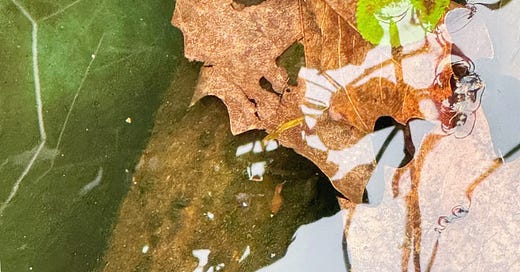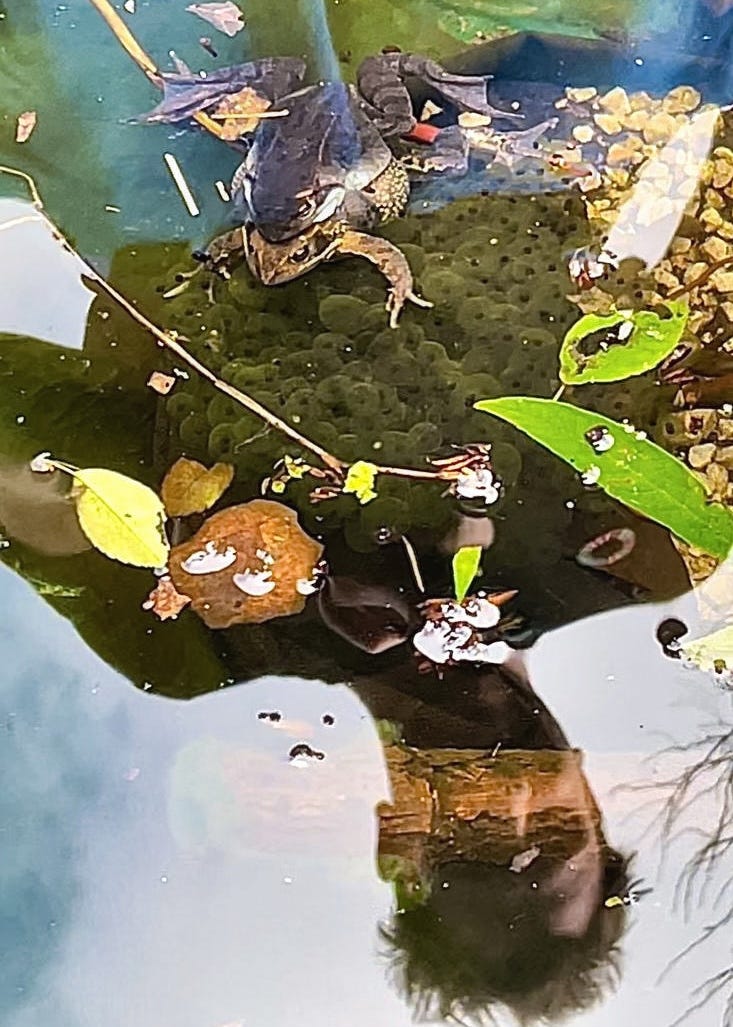Kissing Toads Again
Guest author Peter Carlyon built a wildlife pond in his garden in London last summer and developed what can only be described as a keen interest in toads...
Words and images: Peter Carlyon
It’s Friday, around 3 p.m., and I should at least be pretending to work. Instead I’m crouched down, outside, peering intently into a bog. How are my boys doing? It is four months since a pair of frogs found their way into the garden and splooged translucent spawn about our freshly dug pond, yet little is happening and the thin grey tadpoles that followed haven’t grown in weeks.
My role somewhere between anxious mother and lighthouse keeper, I have become transfixed by this roughly bathtub-sized bog. I check it almost every day, more when working from home. There is something soothing about observing an ecosystem in motion.
Some of the tads sit motionless at the surface like blimps. Others are electric and fizz about the water, darting upwards in pursuit of some imperceptible morsel before bombing back down to the depths. There are other creatures, too: countless squiggling mosquito larvae and conical moss snails hoovering up algae. Sometimes the tadpoles turn on garden snails that crawl into the pond and I find my sweet, innocent lads ravaging the carcass. How did I raise them so wrong?
The whole pond business all began earlier this year. I moved into a new house and for the first time in my adult life had access to a garden. It contained a rank pond, full of a putrid black slop that made you gag. I filled it with fresh water, lined it with gravel, and chucked in the roots of several oxygenating pond plants purchased off the internet. It wasn’t long before a slender, handsome frog made it his home: nicknamed Keanu for his chiselled looks and quasi-spiritual vibe.
Frogs were a symbol of fertility in ancient Egypt, and I can see why. Females are much larger than males, and the two mate by the male clinging tightly to his partner’s back. The ladies in our pond wore Keanu like a backpack. There was barely a moment I saw him in March where he wasn’t clasped onto the rear of some bored-looking female, and he was soon the guardian of a gelatinous mountain of eggs.
There’s something deeply prehistoric about frogspawn. It’s as if you’re watching the entire evolutionary process distilled into several months. Single-celled eggs turn into little black commas, which swell into sperm-shaped tadpoles barely several millimetres long. They stay that way for months, some even remaining so over winter. Then, without warning, over several days they sprout legs and arms. They promptly devour their tails and march onto land, miniscule, smaller than the tadpoles they once were but whole and perfectly formed.
My favourite stage, I think, is when they’re right on the cusp of becoming frogs. They have limbs and are mostly frog-like, but retain their tails and so look like little gold dragons. They appear almost confused to have grown legs, not unreasonably, still processing the chemicals of instinct whirring inside them that soon propel them away.
There’s a tweet I think about sometimes, that goes something like,
“as you age, it’s incredible how quickly birdwatching creeps up on you. You spend 100% of your life being totally indifferent to birds, and then one day you’re like, ‘is that a yellow rumpled warbler?’”.
Like most kids I was obsessed by nature, and like most young adults my interest fizzled away. But as you get older you start wanting to reconnect. Nightclubs lose their thrill, sports get harder to maintain, and you start seeking out tranquillity. But why should it just be birds?
Orwell wrote about toads, arguing devotedly that they were a prized jewel of spring but looked down upon by polite society. He wrote that the common toad had “about the most beautiful eye of any living creature” and should be cherished. But in the 80 years since, not much has changed but that the common toad is no longer common. Its numbers fell 68% between 1985 and 2016, and BBC Springwatch presenter Kate Bradbury has warned that “we could lose all our common toads by 2030”.
For my money that’s a shame. Frogs are a fun and accessible form of nature, able to find their way to even the scattiest of gardens in relatively central London. They might lack the variety and cultural heritage of birds, but they’re easy to attract, plentiful, and contain most of their activities to a watery arena. Seeing a teenage frog hopping about the garden, I felt like a proud dad.
It’s late summer now, and I am back on my haunches at the brim of the pond. Most of the tadpoles have gone. I spot one, a big lad, late to develop but sprouting muscular hind legs. In a few days he will go too. I can’t help feeling weirdly proud that North London might soon be up a couple of frogs. The turning of the earth propels us back to nature, and for many of us that means birds and long walks in the country. Those are great. But I would heartily recommend the bog.








What a charming way to explain the common frog so easily ignored. I shutter when I think of my highschool days when they were used for anatomy experiments. May God forgive me. I am so taken up with our lovely earth and her gifts that I cannot imagine doing anything harmful. I almost kneel in admiration. Thank you so much for your insights.
Great to read the story. We’re waiting patiently for the toads to find their way to us!